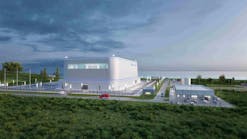CHP, Renewables & Energy Efficiency upgrades at DePauw University save almost $800K in first year
A wide ranging revamp of on-campus energy generation and efficiency systems at DePauw University in Indiana has saved the school nearly $800,000 in the past year, officials say.
Most projects planned by the DePauw Campus Energy Master Plan are completed and in operation, including a conversion of the district energy heating system from steam to hot water, a cooling system energy efficiency upgrade, campus LED lighting and new optimization technology for heating, ventilation and air conditioning (HVAC) controls. The plan also included a solar power project.
So far, the university reported, the benefits since 2017 include a 33 percent reduction in on-campus energy use and a 7,303-ton reduction in annual greenhouse gas emissions.
“Our campus energy master plan (CEMP) formally began in December 2016,” Chris Hoffa, the DePauw campus director of facility operations, said as quote in the university website release. “Our CEMP partner, Ecosystem Energy Services, was chosen and design work began in March 2017. Actual construction work started in May 2018 and the entire project was completed in March 2021.”
Tulane University inks 30-year Energy O&M deal with Bernhard Focused on CHP, Renewables & Efficiency
The university’s combined heat and power plant is being upgraded. The piping networks which distribute heating and cooling across campus are undergoing pipe replacement, and
The piping networks that distribute heating and cooling across the campus are undergoing essential work, replacing fractured and leaking pipes. A mile of trenches, around four feet deep, will be dug to accommodate durable new piping in preparation for an energy-efficient upgrade of the heating and cooling system.
The roof structure of the DePauw indoor tennis and track complex was modified to support the solar photovoltaic array. So far, the reduction in electricity and natural gas costs totaled nearly $800,000, which can utilized to benefit school endowment funding and/or utilized for other programs campus-wide, Hoffa said.
SunPeak was the contractor on the solar project at the indoor tennis and track facility. The 240-kW array includes 800 solar panels.
Click here to read more about the DePauw University Campus Energy Master Plan.
Established in 1837 and located in Greencastle, Ind., DePauw University is spread across 655 acres and serves nearly 2,500 undergraduate students.
----
(Rod Walton, senior editor for EnergyTech, is a 14-year veteran of covering the energy industry both as a newspaper and trade journalist. He can reached at [email protected]).





